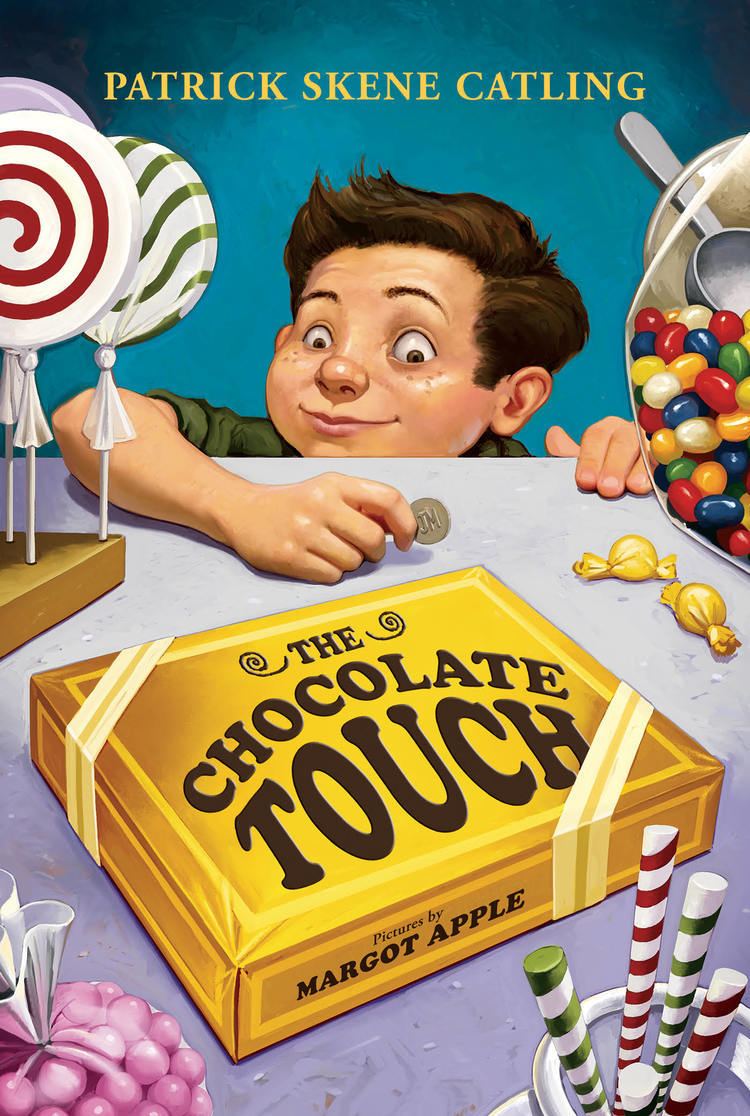8.2 /10 1 Votes8.2
4.3/5 Barnes & Noble Pages 95 Country United States of America | 3.9/5 Goodreads Language English Originally published January 1952 Page count 95 OCLC 1470182 | |||||||||||||||||||||||||||||||||
 | ||||||||||||||||||||||||||||||||||
Illustrator Mildred Coughlin McNutt Characters John Midas, Dr. Cranium, Mrs. Midas, Candy Shop Owner, Mr. Midas Similar Patrick Skene Catling books, Chocolate books | ||||||||||||||||||||||||||||||||||
The chocolate touch by patrick skene catling
The Chocolate Touch is a children's book by Patrick Skene Catling, first published in the USA in 1952. John Midas is delighted when, through a magical gift, everything his lips touch turns into chocolate. The story is patterned after the myth of King Midas, whose magic turned everything he touched into gold. The original illustrations were by Mildred Coughlin McNutt, but another edition in the same year, a "newly illustrated" edition, had illustrations by Margot Apple and more pages.
Contents
Summary
John is a young boy with an intense love of confectionery, especially chocolate. The family doctor warns John that his health is poor, and until further notice, he is to eat only those foods that are conducive to a healthy body, much to the boy's disgruntlement. The doctor's orders are backed by John's folks, who dispose of their son's entire candy stash and have control over his spending money. Angered at having his life micromanaged, John goes for a walk to clear his head. Whilst on his excursion he sees a coin on the ground, and thinks his good fortune as a way to buy a quick fix of chocolate, only to be dismayed to think the coin must be a novelty, as it is engraved with the image of a fat boy and the letters J.M Even so, John remarks the coin is unique as J.M stands for John Midas, and decides to hang on to it. Also on his walk he comes across a candy store he has never seen before. Even more odd is that the store is run by a shopkeeper whom John has never met before, but is friendly and refers to John by name and extols his chocolate as the finest ever. The confectioner offers John a box of his chocolates in exchange for the strange coin. That night before going to bed, John decides to have one final chocolate feast, only be dismayed to find the box contains nothing save for an ordinary chocolate ball, which does not taste overly different from most other types of chocolate. However, the next morning, John is amazed to find everything he eats is chocolate. Then, the Chocolate Touch's effects go into full swing, and whatever touches his mouth turns to chocolate. He cannot properly hydrate himself this way. Then, he gets tired of eating chocolate and begins to view foods with nutrients as the tastiest delicacies on earth. He spoils a birthday party when bobbing for apples later in the day. John's dad asks where he got the chocolate, but both are dismayed when the candy shop mysteriously vanishes. They go to Dr. Cranium, the family physician, who tries to give John a horrible-tasting tonic. John spits out chocolate syrup and a chocolate spoon. Dr. Cranium decides to name the disease "Cranium's disease" and Mrs. Midas cries when she finds out about the disease.John tries to kiss his mother, who also turns to chocolate. He rushes to the chocolate store, which has now reappeared, and the chocolate vendor forgives him. Everything returns to normal and the sweet shop disappears once and for all.
Themes
The Chocolate Touch covers roughly the same narrative as the myth of King Midas, but in changing the object of its protagonist's desire, modifies its target in significant ways. The myth of King Midas, who loved gold above all things, targets greed as its main theme, while The Chocolate Touch highlights another of the Seven Deadly Sins, gluttony. Both stories deal with self-centeredness vs. compassion, though The Chocolate Touch does so in a manner accessible to children, although John's self-centeredness is unlike most other cases of self-centeredness that put other people at a disadvantage; in John's case he wants his family to stop telling him what he can and cannot eat.
Towards the end of the story John comes to realize that his parents' and doctor's demand for healthy eating was for his own good. While people reading the myth of King Midas may not all have daughters of their own, almost all have mothers. In recasting the Midas story with a younger protagonist, author Catling hits on some of children's worst fears, albeit with a light touch.Significance
The Chocolate Touch is still in print, and is often used in grade school curricula throughout the United States. It won the Massachusetts Children's Book Award in 1989, the Utah Children's Choice Honors Award in 1983, and the Beehive Award from the Children's Literature Association of Utah in 1983.
